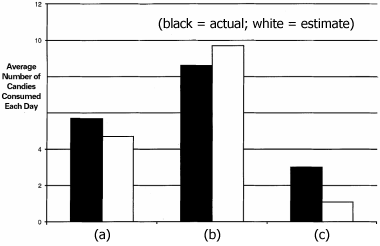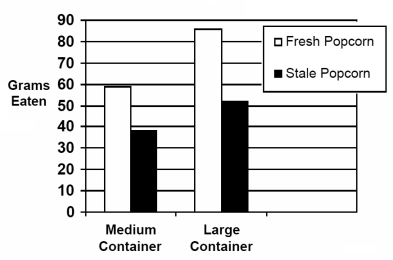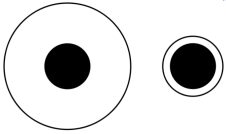1. What factors contribute to feeling hungry or full?
2. Describe the sensory factors involved in eating.
3. What are some hedonic responses to flavour?
4. What genetic and environmental factors affect taste, flavour, and food preferences?
5. Compare and contrast how matching law and optimal foraging theory account for food choice.
6. How do the eating environment and food environment affect food consumption norms and consumption monitoring?
7. How can people’s overserving of food be reduced?
- kinds:
• metabolic or ___________ hunger: driven by physiological necessity
• _______ hunger: eating for the sake of pleasure; a powerful desire for food in the absence of any need for it
- affected by:
• peripheral factors (e.g., food in gastrointestinal tract)
• central factors (e.g., hypothalamus)
• some psychological factors, too (e.g., perceived time of day)
Schachter & Gross (1968):
- normal-weight and obese people recruited for a “taste test” of new Wheat Thins crackers
- participants were given a long questionnaire to complete and an unlimited supply of crackers
- experimenters manipulated the clock to run a) twice as fast or b) half as fast
- obese participants ate more than twice as much as normal participants when the fast clock apparently indicated that it was ______ time (but ate half as much when it was actually dinner time, but the clock was slow)
Gustation
- taste ______: ability to detect and identify a tastant
- taste sensitivity: rating of intensity of the tastant
- “true taste” differentiates gustation from terms like “_______”
- basic taste qualities: sweet, sour, salty, bitter, and _____ (savoury taste)
- other qualities (metallic, alkaline, kokumi ) not universally accepted
- _______ attributes can express nontaste value (e.g., “Scrooge is a bitter man.”)
Olfaction
- odour names often derived from the object that produced it
e.g., minty, smoky
- common substances, however, are ________ of odourants
e.g., evergreen, curry, coffee
- categorization is by comparison
- two olfactory routes:
• __________: via external nares
• __________: via back of the mouth through the nasopharynx
- some odours are disliked orthonasally, but liked retronasally (e.g., strong cheese, fish, eggs)
- it’s more difficult to use retronasal route to ________ food (e.g., using soups and juices syringed into the mouth)
Flavour
- flavour is primarily comprised of taste and smell, but also touch/texture (mouthfeel), temperature, sight, sound, and sometimes pain/irritation (but not in equal quantities)
- no ____ exists in English to express the perception of flavour
- closely linked to systems for learning, memory, emotion, and language--which all contribute to food preference and food cravings
- gastrophysics is the scientific study of the factors affecting our multisensory experience of food and drink; combines gastronomy and psychophysics
• taste/smell interactions:
- tastes can affect the perceived intensity of aromas, and vice-versa (Noble, 1996)
e.g., subthreshold concentration of benzaldehyde (cherry/almond aroma) is detectable when paired with subthreshold sodium saccharin (sweet taste)
(but this does not occur with taste of MSG)
• temperature:
- as food is heated, there is an increase in ________ compounds released, possibly increasing intensity of odours
- wide variation in detection of tastes as temperature increases
• colour:
- it is more difficult to ________ inappropriately coloured foods, including jelly, sherbet, wine gums, and fruit-flavoured beverages (DuBose et al., 1980)
e.g., lemon-flavoured wine gum coloured red tastes like...?
e.g., sailors on WWII submarine fed up with lemon Jell-O; liked it better when it was coloured red
e.g., wine experts described white wine dyed with tasteless, odourless red colour with more red-wine odour terms (Morrot et al., 2001)
- also, increasing intensity of colour increases perception of taste/flavour intensity of drinks, cakes, cookies, sherbet, custard, and candy (Delwiche, 2004; DuBose et al., 1980)
• texture:
- higher viscosity (“thicker” solutions) decreases taste and flavour intensity
- interacts with sound:
• _________ is the “amount and pitch of sound generated when the sample is first bitten with the front teeth”
• ___________ is the “amount of noise generated when chewing with the back teeth”
• sound:
- noise (e.g., on airplanes) decreases flavour perception, making food taste blander
- can sound enhance flavour perception?
Zampini & Spence (2004):
- can perception of crispness and freshness of potato chips be affected by modifying the sounds produced during biting?
- participants sat in a soundproofed experimental booth, facing a microphone, wearing headphones, and bit into ________®
- independent variables: manipulated auditory feedback by increasing sound level (up to 40 dB), and selectively amplifying high frequency sounds (2 kHz - 20 kHz)
- dependent variables: judgments of crispness and freshness
- results: chips were perceived to be ________ by 25% (dB manipulation), or 15% (frequency manipulation)
- similar results found for freshness judgments
- auditory cues play a role in the perception and evaluation of foodstuffs
- implication: crispier foods seem to be fresher
• ____________: sensations of irritation or “burn” that arise when chemical compounds in foods activate receptor mechanisms for pain, touch, or thermal perception (Green, 1996)
e.g., capsaicin from chili pepper, menthol in mouthwash, stinging sensation of carbonation in the nose
- high concentrations of some tastants or odourants cause irritation (e.g., salty NaCl or fruity butyl acetate)
- although taste and odour compounds produce adaptation, irritants cause _____________: increasing irritation and pain in the short term
- preference for spicy foods may be due to desensitization over the long run, and/or association with other flavours
_______ ________: affective (i.e., pleasure) response to foods or their components (Tuorila, 1996)
- liking of a food increases chewing and swallowing rates (you eat faster)
Pleasure principle:
- eating has been called one of life’s greatest pleasures
- endogenous _______/endorphins implicated in food cravings
• preferences for sweet taste are under opioid control: opioid agonists increase, whereas antagonists decrease, preferences for sweet taste in humans
• alcohol cravings may be mediated through endogenous opioid peptides; naltrexone (Vivitrol®, an extended-release opioid antagonist) used to treat alcohol cravings in alcoholics
Taste:
- innate preference (sweet, salty), or rejection (sour, bitter)
- plant-derived alkaloids and glycosides and other environmental toxins tend to have a bitter taste; identifying (and rejecting) bitter compounds may confer an evolutionary advantage
- exposure may (sweet, salty), or may not (sour, bitter) modify liking
- ______ or need increases liking of sweet or salty, respectively
- sensory-specific satiety: satiety decreases hedonic reactions
- age raises preferred concentrations (sweet, salty)
- presence of sugar, fat, or calories enhances liking
Odour (ortho- and retronasal):
- difficult to do research on innate preferences
- pleasure obtained from smells reflects experience (e.g., one learns to love chocolate and hate feces) via ____________
- exposure modifies liking
- age raises preferred concentrations
Engen (1982):
- exposed 1- and 2-year-olds to odourants
- children’s responses rated by observers
- no differences in reactions to odourants adults find pleasant (amyl acetate (pears), lavender) and unpleasant (dimethyl disulfide (garlic-like), butyric acid (vomit-like))
- by age 3, children’s preferences begin to _____ those of adults
__________ stimulation (e.g., of free nerve endings, by spices or ethanol):
- inherently unpleasant
- exposure enhances liking (“hedonic reversal”), which may be due to the antimicrobial properties of chilis, or the presence of vitamins A and C)
Individual differences:
- may be innate or learned
- variation within a population can be due to cultural variation, demographics (e.g., age or sex), or psychographics (e.g., attitudes like _________ or health)
- _______ _______: the best concentration of a substance in a particular food or beverage
• differs among foods/cultures, but generally has an inverted-U shape with increasing concentration
• must be expected (i.e., in appropriate context--not salt in your ______)
(Drewnowski, 1997; Sørensen et al., 2003)
Genetics: some tastes inherently preferred, some inherently disliked
• sweet
- preference for sweet is stronger than for any other taste
- sweet foods tend to contain sugar, which is high in calories and thus energy
- newborn babies suck sugary _______ more
• salty
- strong preference also exists for salty tastes
- salt is required for regulating the body’s fluid balance
- ________ do not appear capable of detecting salty tastes
• bitter
- bitter taste not preferred
- ____________: people who are more sensitive to bitter compounds in foods including coffee, grapefruits, and beer
- correlated with increased number and density of certain papillae on the tongue containing taste buds
The Environment: the effects of experience and social factors
• familiarity (a.k.a. the ____ ________ effect)
- with repeated exposure, new foods will be accepted
- only when the food was actually ________ did this occur
- due to learned safety: when ingestion is not associated with negative consequences, increased acceptance results
- exposing children to novel fruits (e.g., lychee, papaya, sugar palm) 8-10 times increased preference; must involve tasting the food (Birch et al., 1987)
- research shows infants require minimum 8-10 exposures needed; clear increase in acceptance after 12-15 (Sullivan & Birch, 1994)
- flavours of foods (e.g., garlic, vanilla, mint, carrot, alcohol) and tobacco consumed by lactating mothers are transmitted into breast milk; babies later prefer these tastes
- ________ _____ takes on odours of garlic and alcohol, when consumed by pregnant women
• conditioned taste aversion (___)
- tastes previously associated with “negative postingestive consequences” (nausea or vomiting) are avoided
- adaptive response to potentially dangerous toxins
- types of food aversions:
• ___________: aversive taste, smell, or texture
e.g., room-temperature milk
• _________: foods we reject because of reputed/anticipated negative consequences
e.g., poisonous mushrooms
• _____________: considered inedible/minimal nutritive value
e.g., tree bark
• __________: considered offensive; rejected both on ideational and sensory grounds
e.g., urine
• ________ effect
- foods associated with recovery from illness may become preferred
• _______-_______ learning
- pairing novel taste/flavour with a preferred one increases preference for it
- people given unfamiliar herbal teas, some sweetened, others unsweetened ![]() preference for sweetened tea increased (even when presented unsweetened)
preference for sweetened tea increased (even when presented unsweetened)
• _______-________ learning
- tastes associated with higher calories are preferred
• _______ effect
- following a particular meal (potatoes), rats given dessert (sucrose) ![]() decreased preference for potatoes
decreased preference for potatoes
- flavour of sucrose more closely associated with the postingestive consequences of potatoes than the flavour of potatoes
- implications:
• eating dessert at the end of a meal increases preference for the sweet taste of the dessert
• rewarding a child for eating spinach with a dessert will not increase preference for spinach, but will increase preference for the dessert
• ______ factors
The reformatory study (Escalona, 1945):
- mothers in prison had their children living in the prison nursery
- many babies showed dislike for tomato or orange juice
- each juice was offered with equal frequency; equal numbers of babies preferred each juice
- preferences reversed every few weeks
- reversal occurred when person feeding a baby was reassigned
- babies’ preferences/dislikes _______ those of their current caregiver
• culture/cuisine
- depends on:
• _________ foods (e.g., xocolatl in Aztec cuisine)
• __________ (e.g., Native Americans processed corn with lye to increase bioavailability of some proteins and release niacin, which prevents pellagra)
• ___________ (e.g., use of cayenne pepper in Cajun cuisine)
• cultural ___________ (e.g., religious law may forbid some foods)
[insert lecture here]
Wansink, Painter, & van Ittersum (2001):
- six popular dishes selected from menu of faculty cafeteria at U of Illinois
- menu signs listed dishes with basic or descriptive (e.g., geographic, affective, or sensory) labels:
“Red Beans with Rice” vs. “Traditional Cajun Red Beans with Rice”
“Seafood Filet” vs. “Succulent Italian Seafood Filet”
“Grilled Chicken” vs. “Tender Grilled Chicken”
“Chicken Parmesan” vs. “Home-style Chicken Parmesan”
“Chocolate Pudding” vs. “Satin Chocolate Pudding”
“Zucchini Cookies” vs. “Grandma’s Zucchini Cookies”
- diners completed questionnaires
- sales of dishes with descriptive labeled increased 27%
- descriptively labeled foods rated as having better taste and texture, and more ________
(Wansink, 2004, 2006)
- food choice (what we eat) is different from food consumption volume (how much we eat)
- although people acknowledge that environmental factors influence others, they (_______) believe they are not affected
Mediating factors:
1. consumption _____: aspects of the environment influence the quantity of food that is acceptable to consume
e.g., package size, or eating behaviour of your dinner companion
Wansink, van Ittersum, & Painter (2006):
- participants were 85 food and nutrition experts who attended an ice cream social
- randomly received a 17 oz (482 g) or 34 oz (964 g) bowl and served themselves ice cream
- then filled out survey estimating amount of ice cream they took, while bowls were secretly _______ (82 ate all the ice cream)
- those who used the larger bowl ate 31.0% more
- did not perceive they ate more with larger bowls
2. consumption __________: monitoring food consumption helps reduce discrepancies between perceived and actual consumption amounts
e.g., paying attention to the amount eaten vs. eating until all the food is gone
- food choice may be emphasized to the neglect of food quantity
e.g., eating a whole package of low-fat cookies
Wansink, Painter, & North (2005):
- served tomato soup in bowls continuously ________ via hidden tubes
- people ate 250 mL from normal bowls
- but ate 435 mL from refilled bowls (73% more; did not believe they consumed more; did not feel more full)
- ______ ____ affect consumption
• ____________: ambient characteristics that influence the eating environment
e.g., dimmed/soft lighting increases comfort and eating duration, which lead to greater consumption
e.g., unpleasant odours shorten meal duration and food consumption
e.g., soft music encourages slower eating rate, longer meal duration, and greater consumption; loud or uncomfortable music can cause quicker eating and less consumption monitoring
• ______: ease, access, or convenience with which food can be consumed
Painter, Wansink, & Heiggelke (2002):
- secretaries were given dishes containing 30 Hershey’s® Kisses®, refilled every evening, for 3 weeks
- put dish:
a) in desk drawer (not visible/convenient)
b) on desk (visible/convenient)
c) on shelf 2 m away (visible/inconvenient)
- surreptitiously counted Kisses® eaten; secretaries estimated consumption:

- those with candies on their desk ate average of 5.6 more/day than those with candies on the shelf
- overestimated on-desk consumption by 13%; underestimated on-shelf consumption by 63%
- ______ access to food increases consumption
• ______ facilitation: the presence of others influences what is eaten, and increases the amount
de Castro & Brewer (1992):
- found dramatic link between number of dining companions and consumption
- meals eaten with another person were 33% larger than meals eaten alone
- further increases:
number of others: |
2 |
3 |
4 |
5 |
6 |
7 |
increased food consumption: |
47% |
58% |
69% |
70% |
72% |
96% |
- less variability in amount consumed as number of companions increases
- only works if you are with people you know; when eating with a stranger, the effects disappear
• ____________/attention: can initiate “scripted” patterns of food consumption; can reduce monitoring; can extend meal duration (Robinson et al., 2013)
- people snack more while watching TV (or playing video games), even if they are not physically hungry
- patients with _______ who were told it was dinnertime ate a second complete meal only 10-30 minutes after having eaten a meal (Rozin et al., 1998)
Wansink & Park (2001):
- gave free popcorn to moviegoers in Chicago (afternoon screenings of Payback)
- more attention paid to movie: more popcorn was eaten
- people ate more if accompanied by a person of the opposite ___
• ______: choice of terms used to describe food can frame different attributes, affecting consumption
Turnwald et al. (2019):
- university dining halls displayed one of three kinds of labels for identical vegetable dishes:
• health-focused label (e.g., “Healthy Choice Turnips”)
• basic label (e.g., “Turnips”)
• taste-focused label (e.g., “Herb n' Honey Balsamic Glazed Turnips”)
- recorded food selection and consumption
- taste-focused labels:
• increased perception of _________
• increased selection by 14%-29%
• increased consumption by __%
• ________: seeing (or smelling) a food can increase hunger and can stimulate unplanned consumption
e.g., people asked to write a description of the last time they ate soup increased their consumption of canned soup (ate 2.4 times more than control group)
Wansink, Painter, and Lee (2006):
- secretaries were given covered dishes containing 30 Hershey’s® Kisses®, refilled every evening, for 4 weeks
- 2×2 design:
• dishes were placed on desk, or 2 m away
• bowls were clear, or ______
- candies in clear containers consumed 46% more quickly than those in opaque ones
- consumption affected by visibility (and location)
• _______ and structure: (perceived) variety can make one believe they will enjoy the assortment more, and may suggest an appropriate amount to eat; “organization” of food also affects consumption
e.g., if offered three kinds of yogurt, people eat 23% more than if offered only one flavour
Kahn & Wansink (2004):
Study A
- gave people 300 M&Ms® while watching Hazzard County
- those given bowl with 7 colours ate 64
- those given 10 colours ate 91 (43% more)
Study B
- gave people 300 jelly beans, in six flavours
- those given organized assortment ate 13
- those given disorganized ate 22 (69% more) and rated the assortment as having more variety
• size of _______/proportions: as package size increases, so does consumption--even when the energy density of the food is altered to compensate
(upshot: ______ is a better indicator of “fullness” than calorie density of food!)
- larger packages suggest larger consumption norms
Wansink & Kim (2005):
- gave free popcorn to moviegoers in Philadelphia at screenings of Stargate
- 2×2 design:
• bucket was medium (120 g) or large (240 g)
• popcorn was fresh or stale (14 days old)
- questionnaires given after the movie
- results:

• fresh popcorn: 45.3% more eaten when given in large container
• stale popcorn: 33.6% more eaten from large container
- package size can influence the consumption of ____________ foods
• __________ food: “warehouse”-sized food takes up much space, and is highly salient
Chandon & Wansink (2002):
- stocked people’s houses with eight different foods (e.g., juice, granola; oatmeal, noodles)
- given moderate (4) or large quantities (12)
- monitored consumption over 2 weeks
- stockpiled convenient ready-to-eat foods were eaten at _____ the rate of nonstockpiled foods
• _______ __________: container may act as perceptual cue influencing consumption; over 71% of one’s caloric intake is consumed using serving aids (e.g., bowls, plates, glasses, etc.)
Wansink & Van Ittersum (2005):
- Jean Piaget: in a conservation task, pre-concrete operational children (younger than 7) show centration: focus on one dimension (e.g., height of glass) at the expense of others (e.g., width of glass)
- horizontal-vertical illusion:

- people overestimate ______ by 20%
- in previous study, gave adolescents (at nutrition and weight camp) tall/narrow or short/wide glasses: poured 88% more into short/wide glasses, but believed they poured less
- what about experts?
- 86 Philadelphia bartenders with an average of 6.3 years’ experience
- given 4 highball glasses and 4 tumblers; both types held 355 mL
- also given 4 full 1,500 mL bottles (gin, rum, vodka, whiskey)
- asked to pour 1.5 oz “single shot” (44.3 mL)
- results:
• poured 46.1 mL into tall/narrow glasses
• poured 55.5 mL short/wide ones (20.5% more; same experiment with students: 30.0% more)
- implications: use highball glasses, or _________ glasses
- criticisms: bartenders were not allowed to use _____, shot glass, or counting (“one-Mississippi...”)
van Ittersum & Wansink(2012):
- surface area of the average dinner plate has increased 36% since 1960
- ________ illusion (1865): central disks are the same size

- will a serving on a larger plate be underestimated, compared to the same amount on a smaller plate?
- people served themselves __% more on a 12-inch plate (area = 113 in2) than on a 10-inch plate (area = 79 in2)
- however, overserving decreased if attention was drawn to the Delboeuf illusion
- overserving effect is enhanced if there is:
• low contrast between food colour and plate colour (e.g., red pasta sauce on red plate): 22% increase
• high contrast between plate colour and tablecloth colour (e.g., red plate on white tablecloth): 10% increase
Ways to reduce overeating and overserving:
• eat more slowly, and pay more attention to the food
• increase food-dinnerware colour contrast, and decrease dinnerware-tablecloth colour contrast
• draw attention to target serving size and dinnerware
• educate people about the effect of visual illusions on food consumption volume
• the Small Plate Movement attempts to help people lose weight by simply reducing the size of their __________